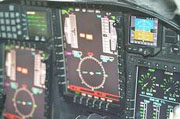VOA标准英语2011--U-2 Spy Plane Still Flying High
搜索关注在线英语听力室公众号:tingroom,领取免费英语资料大礼包。
(单词翻译)
U-2 Spy Plane Still Flying High
One of the oldest planes the United States Air Force still flies is used to carry out some of America's most sensitive and critical missions. Whether it's aiding NATO troops in Afghanistan, providing surveillance over North Korea or examining Japan's hurricane ravaged1 coast, the high altitude U-2 keeps flying despite initial plans to retire it by the end of this year.
It requires a lot of skill and technology to get a pilot above 21,000 meters where the U-2 snaps critical images and gathers intelligence.
One hour prior to takeoff, the pilot begins inhaling2 pure oxygen to cut the risk of decompression sickness.
Major Colby Kuhns of the U.S. Air Force 5th Reconnaissance "Blackcats" squadron said it is like being atop Mount Everest.
"I haven't had any decompression problems, so that's good. But we are susceptible3 to it. Guys who start getting those symptoms will feel pain in their joints4 and it could get worse than that," said Kuhns.
 |
| A U-2 flies at low altitude on an overcast5 Korean morning, Osan Air Base, South Korea, December 2011. |
Landing the spy plane, nicknamed Dragon Lady, also requires unique abilities.
The pilot, sometimes finishing a grueling flight of up to 12 hours, has poor forward visibility in the cockpit. Because the wide-winged jet has an unusual bicycle-type landing gear, a second pilot in a very fast car on the runway chases each landing, radioing observations to his colleague in the cockpit to help him maintain a full stall at precisely6 60 centimeters off the ground.
When the U-2s return from flights, the Blackcats' maintenance team, overseen7 by Lieutenant8 Danielle Rogowski, tracks about 150 items on the jet that need to be replaced at certain intervals9.
"Flying at that high an altitude, you do a significant amount of wear and tear on the aircraft and, a lot of these components10, with the temperature changes and temperature extremes, puts a lot of pressure on them," said Rogowski.
 |
| A closeup view of the U-2 cockpit instrumentation, Osan Air Base, South Korea, December 2011. |
The first U-2 took to the skies in 1955. Originally, the Air Force provided the squadron commanders and logistical support while the Central Intelligence Agency supplied operations officers, pilots and mission planners. A newer version, 40 percent larger than the original U-2, was produced in the 1980s. In the 1990s, U-2s were outfitted11 with new engines.
Major Carl Maymi, sitting in the cockpit prior to a low altitude training session in a relatively12 new U-2 built in the 1980s, points out the U.S. Air Force also still has bombers13 from the 1950s.
"So by other Air Force weapons systems standards it is relatively new. You can take a look at the inside of the cockpit and the wiring throughout the jet, the motor and especially the sensors14 we have on board. hat stuff is all state of the art. It's advanced. So I feel real comfortable with an aircraft that is technically15 50-plus years old," said Maymi.
One reason the U-2 was designed to fly very high was to avoid being shot down. But that is precisely what happened in 1960 when a Soviet16 missile struck one of the spy planes.
 |
| A high-altitude view from the U-2 cockpit, December 2011. |
Pilot Francis Gary Powers, whose CIA U-2 was recovered nearly intact, was captured. He was put on trial in Moscow and convicted of espionage17.
In addition to the traditional Cold War era intelligence missions, U-2s also now provide real-time assistance to troops in combat zones, such as Afghanistan.
"It's evolved as it's needed to evolve. It is cutting edge right now and very well could go out into the future, if necessary," said Kuhns.
Its future has been questionable18 for some time. The Defense19 Department, five years ago, intended to begin retiring the fleet. But Congress insisted the spy plane stay aloft until unmanned reconnaissance aircraft are capable of taking over its critical missions.
The Air Force now says that will happen in 2015 when the Global Hawk20 RQ-4 drones can assume the U-2s missions - some 60 years after the venerable spy plane first took to the skies.
 收听单词发音
收听单词发音 




